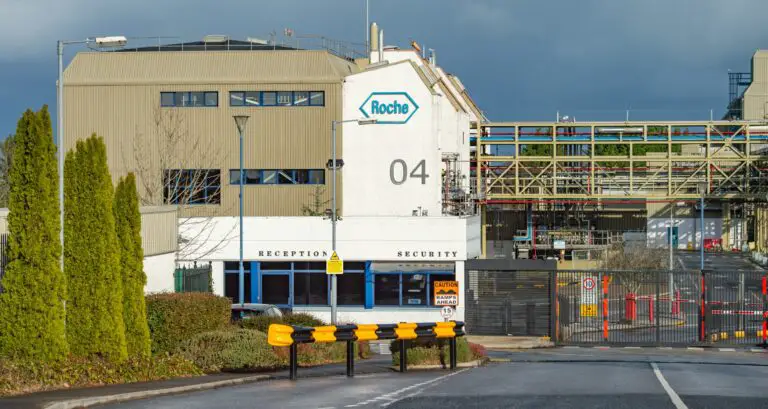*Photograph: Martin Connolly
Conditional planning has been granted for the decommissioning of Roche’s Clarecastle site.
Further information was sought by the local authority when the initial application was lodged in June of this year. In a decision announced last Monday, the green light was given to the development subject to it meeting a set of conditions.
An application fee of €38,000 which is the maximum amount, was paid by the developers who say that up to 160 persons will be employed during the course of the decommissioning work. Contributions which total over €1m have to be paid to the local authority by Roche for use of public infrastructure.
A timeline from June 2021 until May 2028 has been listed for the works on the 88 acre site. Daily water usage is expected to be 35m3 per day with a peak of 9m3 per hour.
All existing buildings will be demolished as part of the works which also include the phased remediation of three Areas of Environmental Concern (AECs) within the site boundary such as the main processing and landfill areas. Bulk excavation of the decontamination units and backfilling of excavated areas also form part of the works. Air emission levels are to be recorded and monitored by the developers.
“As far as practicable, waste will be removed to licensed receiving facilities located in close proximity to the site and within Ireland. As the bulk of waste from AECs require thermal treatment followed by beneficial reuse, these will be shipped to receiving facilities in continental Europe,” the application states. An estimated 39,418 tonnes of waste have been identified at the site, “as a worst case scenario this would need to be disposed of offsite and outside of Ireland at a hazardous waste landfill”. Documents included with the planning file flag that the proposed backfiling works exceed 90,000 tonnes.
Disposing of the waste will involve a peak of 18 heavy goods vehicles (HGV) an hour travelling from junction 11 of the M18 onto the R458, through Patrick St and Clarehill. All works on the site are to take place between 7am and 7pm from Monday to Friday inclusive and between 8am and 2pm on Saturday. Roche estimate that there will be a total of 63,000 HGV movements in Clarecastle throughout the lifetime of the project.
No observations were made by Transport Infrastructure Ireland (TII) or the Health and Safety Authority (HSA) in relation to the project. The Irish Aviation Authority felt the applicant should be conditioned to engage with Shannon Airport to ensure that appropriate wildlife hazard reduction techniques and management is employed throughout the remediation of the site.
Built by the Syntex Corporation in 1974, the site was acquired by Roche Group in 1994. In November 2015, the company announced its plans to exit the site with production ceasing in November 2019. Pharmaceutical operations ceased at the facility on 27th March 2020. It has built up a strong connection with the locality which resulted in a joint submission of support for the project from Clarecastle Tidy Towns, Clarecastle Community Development CLG and Clarecastle Ballyea Heritage & Wildlife.
They stated that the “environmentally sound brownfield development site is of immeasurable value to our future” which poses the possibility of new opportunities that could be “a real socio-economic game changer for Clarecastle and its environs”.
Chairperson of Clarecastle GAA, Niall Tuohy in a submission expressed the view that the transformation of the facility opens the possibility to “bring prosperity and vibrancy back to our village”.
HGV movements prompted concerns in some objections to the works. One Limerick based objector felt there was an intention to move a “colossal quantity of contaminated soil” through Clarecastle with a truck passing “every three to four minutes”. Two residents of the village described the scale of HGV movements as a “nuisance” as they cautioned the industrial development could “straddle the Fergus estuary for considerable time”. Health concerns, air pollution and darkened living conditions were also referenced regarding the frequency of HGV movements.
In a planning report compiled by the Ennis Municipal District, it was detailed by senior engineer Eamon O’Dea that there would be peak HGV movements per day of 220 over a 12 hour period in 2022. He noted that the quantity of traffic movements would not increase significantly in the village of Clarecastle.
A spokesperson for Roche told The Clare Echo described the decision as “a very positive outcome” that can facilitate future use of the site. “Roche Ireland looks forward to receiving a formal grant of planning permission so that work can get underway on this strategic project and the benefits it will deliver to Clarecastle and Co. Clare”.
Clare TD, Joe Carey (FG) welcomed the decision to facilitate the remediate the site. “This work will create a brownfield site ripe for future investment” which he urged IDA Ireland to act on.
Mayor of Ennis, Cllr Paul Murphy (FG) welcomed the announcement and also urged IDA Ireland to make active efforts to attract an investor to the brownfield site over the next decade and noted the site is a key component of the Ennis 2040 plans. He praised the manner in which Roche adapted to public consultation with town hall meetings not permitted and said all local concerns were dealt with. “Roche have always been a good neighbour to Clarecastle and will continue to be”.


















